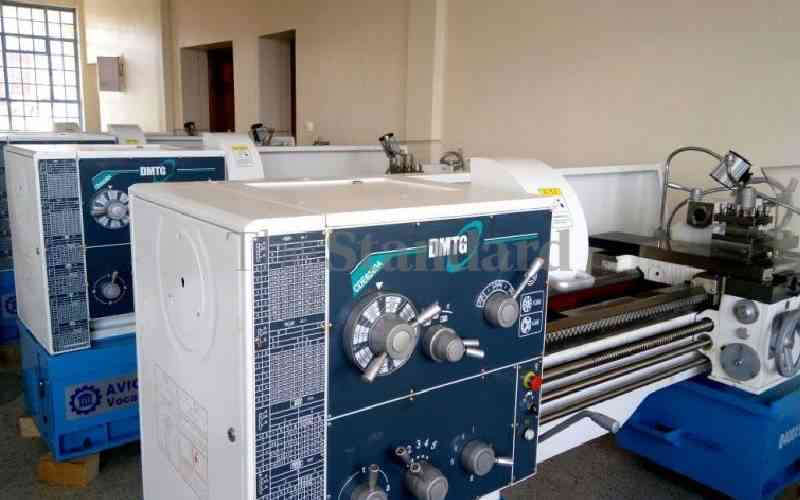By Timothy Makokha in Dubai
It is a revolution of sorts as television moves from viewing to experiencing with the launch of 3D TV in homes and pubs.
Panasonic last week launched a new High Definition 3D television for Africa and the Middle East in Media City, Dubai. This comes weeks after Samsung and LG launched their version of 3D television in the US market last month.
The launch of the 50-inch TV also saw Panasonic introduce a new 3D blu-ray player set to consign DVD players into trash technology. Blu-ray demos on a 50-inch television proved every bit as engaging as it did on the 152-inch screen display.
Building on the success of Avatar, last year’s Sci-Fi Hollywood film that was epic in visual effects and technology, Panasonic is hinging on 3D innovation to drive TV sales.
"We are targeting a 50 per cent market share for large screen 3D TV by 2012, and 25 per cent market share for over 37-inch televisions in Africa and Middle East region," said Seiji Koyanagi, Managing Director, Panasonic Marketing Middle East.
Koyanagi says this year, 3D technology is moving from the preserve of cinema halls to homes and pubs.
"We expect 3D TV to be common in homes within five to 10 years," he said, adding that 3D is the biggest technology coming to television and home movies soon.
It is this 3D technology that crafted the Avatar – a skit of utopian depiction into a near-real and lush world of dense forests, floating mountains, creepy creatures and giant, blue-skinned humanoids in Hollywood.
Kenji Yasuhara, Group Manager Networks Company, Panasonic Corporation, compared the transition from 2D to Full Time High Definition 3D television to the switch from black-and-white to colour television and the shift from standard to high-definition images.
"Thanks to a large number of technological innovations, television has undergone a constant evolution over the years," he said.
While at the start, television was regarded as a means for reproducing images and a passive exercise, its significance increased when connectivity with other audio visual devices was added. It has since moved from watching to experiencing TV with all the senses enlivened.
Live television
The innovation relies on the idea that if separate images are presented to the left and right eyes, the brain combines them and creates the illusion of a third dimension.
Panasonic uses "active eye glasses" and large TVs with high refresh rates to achieve the same effect.
Stay informed. Subscribe to our newsletter
Two images, one for the right eye and one for the left eye, alternate quickly on the TV. Shutters on the 3D glasses swap the viewer’s vision from right eye to left eye at the same rate. The TV connects with the glasses through a sensor that is placed between the lenses on the glasses.
"The effect moves so quickly and the brain is triggered into merging the images and creating the extra perspective needed to see images in 3D, Yasuhara said.
Other TV makers use glasses with polarising lenses.
Attempting to differentiate Panasonic’s 3D innovation from LG and Samsung, Yasuhara said Panasonic developed a new panel generation called NeoPDP 3D with a high eyespeed drive technology.
While I could ill-fit my small head into the giant kooky eye glasses, the 3D pictures of semi-naked women playing beach volleyball was splendid, even disturbing sometimes, as they repeatedly ‘jumped’ off the oversize screen into my laps.
The visuals were also powerful on gaming and high-energy movies but the technology loses vitality with less dramatic episodes like news.
Watching a footage of skiers for instance ticked off my adrenaline as I concentrated on ‘dodging’ snow ‘flying’ off the screen but an episode of a CNN prime time news anchor in 3D lacks the same effect.
The 3D plasma technology offers a number of advantages including reduced cross-talk, crisp and clear high quality moving pictures, enhanced luminance efficiency and improved picture quality even when viewing 2D content.
But 3D is more than just unmatched visuals. The Panasonic 3D innovation is moving from watching to using TV and thinning the line between a picture box and a computer. The 3D TV connects with a compatible keyboard for use as a computer without the need for processor.
The new Panasonic 3D TV also comes with such social networking functions like Skype, Youtube, and Picasa — a software that helps organise, edit, and share photos. The TV is also enabled to read a memory card and Universal Serial Bus (USB) flash.
world cup euphoria
Keen to cash in on World Cup rapture, Anthony Peter, Associate Director Group General Manager, Panasonic Middle East and Africa, says 3D televisions will be hitting the stores in the region just before June, but at a price.
While it is not clear yet how much the 3D television on African markets will cost, it debuted the US market last month at $2,500 (Sh192,500). Consumers will also shell out an extra $150 (Sh11,550) for a pair of 3D eyewear glasses.
Besides investing in the TV, a family of seven for instance – parents and five children (the average number of births per Kenyan woman) — will each need their own glasses.
The glasses themselves have an extra expense of energy consumption. Their batteries need to be replaced every after 100 hours of viewing.
Until the prices come down dramatically, pubs would be the most ideal to buy these TVs, but they also need to buy the glasses for their patrons.
Those who can afford the technology will still have the crucial matter of infrastructure to deal with.
The process of making live television work in 3D will involve a major conversion of broadcast system to digital transmission — a move Kenya has already taken. But this is just half the trek.
Some commentators posit that 3D broadcasts require twice the data and therefore gobble up an unworkable amount of television bandwidth. This, in a country with sky-high costs of bandwidth, does not bode well for 3D TV enthusiasts.
Despite the hurdles, a number of broadcasters have started experimenting with 3D technology in transmission of their programmes.
Sky is touting one version that requires use of a new television and ‘live’ glasses. The glasses are made of two lens; one having horizontal stripes, and the other vertical strips.
BBC, which already runs a high definition (HD) channel, is also toying with introducing 3D broadcasting.
Al Jazeera is also said to be laying ground to test 3D broadcasting.
In Korea, it is reported that two TV channels, KBS and SBS, are embroiled in a tussle on who becomes the first station to beam stereoscopic images to homes.
Despite its sky-high price, 3D television is set to change the face of home entertainment. Many technology enthusiasts have hailed the invention as the next generation of home theatre systems.
—[email protected]
 The Standard Group Plc is a
multi-media organization with investments in media platforms spanning newspaper
print operations, television, radio broadcasting, digital and online services. The
Standard Group is recognized as a leading multi-media house in Kenya with a key
influence in matters of national and international interest.
The Standard Group Plc is a
multi-media organization with investments in media platforms spanning newspaper
print operations, television, radio broadcasting, digital and online services. The
Standard Group is recognized as a leading multi-media house in Kenya with a key
influence in matters of national and international interest.
 The Standard Group Plc is a
multi-media organization with investments in media platforms spanning newspaper
print operations, television, radio broadcasting, digital and online services. The
Standard Group is recognized as a leading multi-media house in Kenya with a key
influence in matters of national and international interest.
The Standard Group Plc is a
multi-media organization with investments in media platforms spanning newspaper
print operations, television, radio broadcasting, digital and online services. The
Standard Group is recognized as a leading multi-media house in Kenya with a key
influence in matters of national and international interest.








